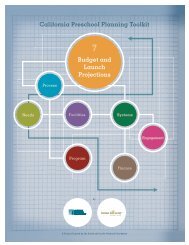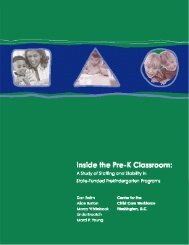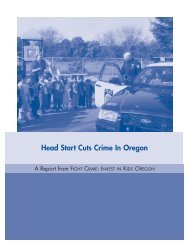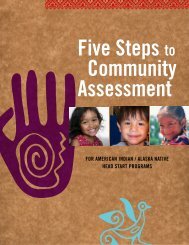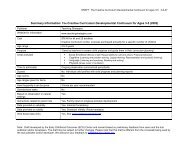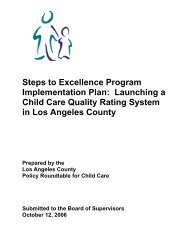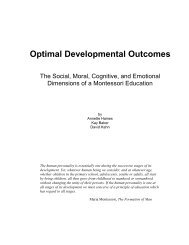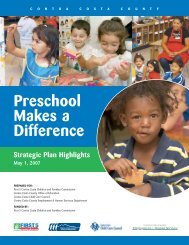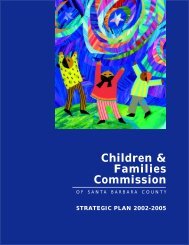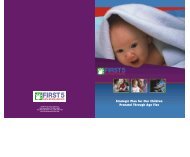Mapping the P-3 Continuum - Foundation for Child Development
Mapping the P-3 Continuum - Foundation for Child Development
Mapping the P-3 Continuum - Foundation for Child Development
Create successful ePaper yourself
Turn your PDF publications into a flip-book with our unique Google optimized e-Paper software.
graduation, as compared to children with no participation; 2) participation beyond kindergartenshowed more successful outcomes <strong>for</strong> children; 3) participants who were in <strong>the</strong> program throughthird grade versus those who stopped in second grade had more successful outcomes through 15years old, particularly lower rates of grade retention and need <strong>for</strong> special education services; 4)delinquency at ages 13-15 years and school dropout rates were also found to be less <strong>for</strong> extendedprogram participants than <strong>for</strong> shorter term participants.The goal of <strong>the</strong> Carolina Abecedarian Project (ABC) was to reduce academic failure in lowincome,rural children. Educational child care was provided to mainly African-Americanchildren beginning at 4 months old through 5 years old. This early intervention was followed bythree years of continued intervention through second grade. Components of <strong>the</strong> earlyintervention included language and literacy skills, low child-to-teacher ratios, and familysupport. The school-age program also included a six-week summer transition prior tokindergarten entry.Key findings are: 1) Extended participation past <strong>the</strong> pre-school component produced higherachievement; and 2) at <strong>the</strong> 15-year-follow-up, <strong>the</strong> extended participation group exceeded <strong>the</strong>non-extended group only in reading achievement, but not math achievement, IQ test scores,grade retention, or special education.The National Head Start/Public School Early <strong>Child</strong>hood Transition Demonstration Project(HST) was implemented in school districts across <strong>the</strong> country beginning in 1991, with federalfunding. This was an attempt to implement <strong>the</strong> original goals of Follow Through. Specifically,<strong>the</strong> goals were to coordinate Head Start and elementary school programs to providecomprehensive support services and encourage parent involvement. In contrast with FT, HSTfocused more on support services and less on instructional activities.Research findings across sites were mixed, and inconsistent. Some sites found no effect,whereas o<strong>the</strong>rs found a positive effect <strong>for</strong> parent involvement on achievement scores in <strong>the</strong> thirdgrade. Ano<strong>the</strong>r site noted positive effects on social skills in <strong>the</strong> first and second grades, as wellas higher parent involvement.SummaryIn summary, both <strong>the</strong> CPC and ABC programs provide evidence that extended early childhoodprograms can promote future school success in disadvantaged populations. The differences in<strong>the</strong> long-term effects between <strong>the</strong> two programs may reflect <strong>the</strong> differences in <strong>the</strong> programs<strong>the</strong>mselves. In particular, <strong>the</strong> ages of <strong>the</strong> participating children differed. ABC children began<strong>the</strong> program at 4 months and continued through second grade, and <strong>the</strong> CPC children began at 3-years of age and continued through third grade. It has been noted elsewhere that <strong>the</strong> third gradeis an important transition grade <strong>for</strong> children 8 , and should perhaps be included in a program thatwants to impact educational outcomes. Additionally, <strong>the</strong> educational contexts were different <strong>for</strong><strong>the</strong>se two groups of kids. CPC children were living in economically disadvantaged, mostlyminority neighborhoods, whereas <strong>the</strong> ABC children attended school in a rural area of NorthCarolina with mostly white middle-class children. Ano<strong>the</strong>r difference between <strong>the</strong> two programs8 Stipek, D. (2002). At what age should children enter kindergarten? A question policymakers and parents. SocialPolicy Report, 16 @), 3-16.7



